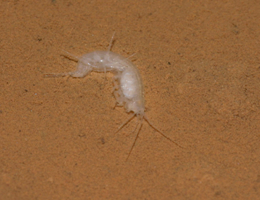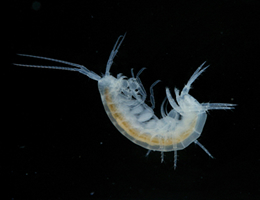
The Niphargus group has representatives throughout Europe. Its members are eyeless and colourless and bear a resemblance to the ubiquitous freshwater shrimp (Gammarus pulex) of surface waters. They occur in a variety of subterranean aquatic habitats where they are generally believed to be saprophagous (i.e. they feed on animal and plant derived detritus). However, they can be predacious on other invertebrates, including smaller Niphargus and Proasllus cavaticus, if the opportunity presents itself.
Niphargus aquilex was first discovered in 1853 by Professor Westwood, who obtained specimens of a subterranean amphipod from a well near Maidenhead, Berkshire. He described them initially as being Niphargus stygius, a species then known from continental Europe. However, in 1855 Schiődte re-examined the material and described them as a new species, Niphargus aquilex.
On average N. aquilex tends to have a more elongated body shape in comparison to other Niphargus and generally most specimens tend to be larger than N. kochianus and N. glenniei. Most British specimens of N. aquilex average 5 to 8mm in length, although much larger specimens up to 12 and even 15mm have frequently been recorded. One of the main features that differentiate N. aquilex is the rounded posterodistal angles on epimeral plates 2 and 3, although this is not so pronounced on juvenile specimens. Lateral spines on the telson lobes and an obtuse palmar angle on the propodus of gnathopods 1 and 2 distinguish this species from N. kochianus. Hartke et al. (2011) recently carried out a comparative examination of specimens in the Niphargus aquilex / schellenbergi / fontanus group. N. schellenbergi bears a superficial resemblance to N. aquilex and in the past the two have been considered sub-species (cf. Niphargus aquilex aquilex; N. aquilex schellenbergi). The presence of a single spine on the dactyl of the gnathopods seems to differentiate N. aquilex from the other two species. Other diagnostic features were included in the paper, although there does seem to be variation in British specimens from those examined, primarily in the number of spines on the posterior margin of the basis of pereopod VII. N. schellenbergi is known from France, Germany, Belgium and the Netherlands and Hartke et al. (2011) highlighted the fact that many specimens from the Hartz Mountains of Germany previously identified as N. aquilex were in fact N. schellenbergi. A re-examination of several larger specimens of British N. aquilex was carried out by Knight and Gledhill, with all British specimens conforming to aquilex morphology. Molecular studies at Hull University have recently highlighted the presence of a distinct N. aquilex clade in Britain with close genetic ties to N. schellenbergi, which might represent a ‘cryptic’ taxon.


Niphargus aquilex is the commonest British niphargid, occurring in wells, interstitial gravels and other subterranean waters in southern England and Wales. It has been recorded from many locations, mostly south west of a line drawn from the East Coast of Kent to the Wirral Peninsula in Cheshire, with most records concentrated in the south. There are modern records from Lincolnshire, South-east Yorkshire and northern Wales, including Anglesey and very old records exist of the species from Hartlepool, County Durham (1893) and Henwick, Worcestershire (1863). This latter group of locations is north of the Devensian limit and imply that they might have been re-colonised by N. aquilex after the last ice age (see section on hypogean Crustacea ecology). N. aquilex is probably widely distributed in ground water and is liable to be found where this reaches the surface (e.g. springs) (Gledhill et.al., 1993). It has been found in low-lying ground (e.g. from under the Sphagnum moss cover of a mash near Wellington) where the soil-water zone is continuous with the phreatic, or ground-water, zone and it is thought that, in England at least, the species may be beginning to invade the soil-water zone (Glenniei, 1956). N. aquilex is occasionally collected whilst kick sampling for benthic macro-invertebrates in rivers and streams and is likely to be widespread in the hyporheic zone of many watercourses.
N. aquilex is more commonly found in groundwater sites (e.g. wells, springs, aquifers and riverine gravels) than in caves and there are few records from the latter. It has been recorded from Rickford Cave in the Mendips, Paviland Cave on the Gower Peninsula, Ogof y Pebyll near Bridgend and from Agen Allwedd, Breconshire, although this latter record is thought to be a mis-identification of Niphargus fontanus. It is common in Holwell Cave in Devonian Limestone in the Quantock Hills, Somerset and frequently occurs in caves in Devon, also in Devonian Limestone. Holwell Cave and the Devon caves differ from most other British caves in their Devonian geology. However it is thought that the main reason for N. aquilex’s presence in caves in the far south west might be the absence of Niphargus fontanus, the most commonly occurring cavernicolous Niphargus, from this area. Competition with the robust and relatively large N.fontanus might exclude N. aquilex from caves in the Mendips and South Wales, although the two species are often recorded together at groundwater sites such as the Town Well at Ringwood and Waterston cress beds. N. aquilex sometimes occurs with Niphargus glenniei in Devon caves, even sometimes in the same pools. However, N. glenniei is much smaller and less likely to be a competitive threat.
As well as mainland Britain and the Isle of Anglesey mentioned above, Niphargus aquilex has also been recorded from the Isle of Wight and Jersey, Guernsey, Sark and Alderney in the Channel Islands. It is also known from central and southern Europe, including Italy and the Balkans and is one of the most widely distributed species in Europe, although molecular studies (e.g. Trontelj, 2009) have shown that this distribution in fact consists of a complex of several cryptic species, each with much smaller ranges.
